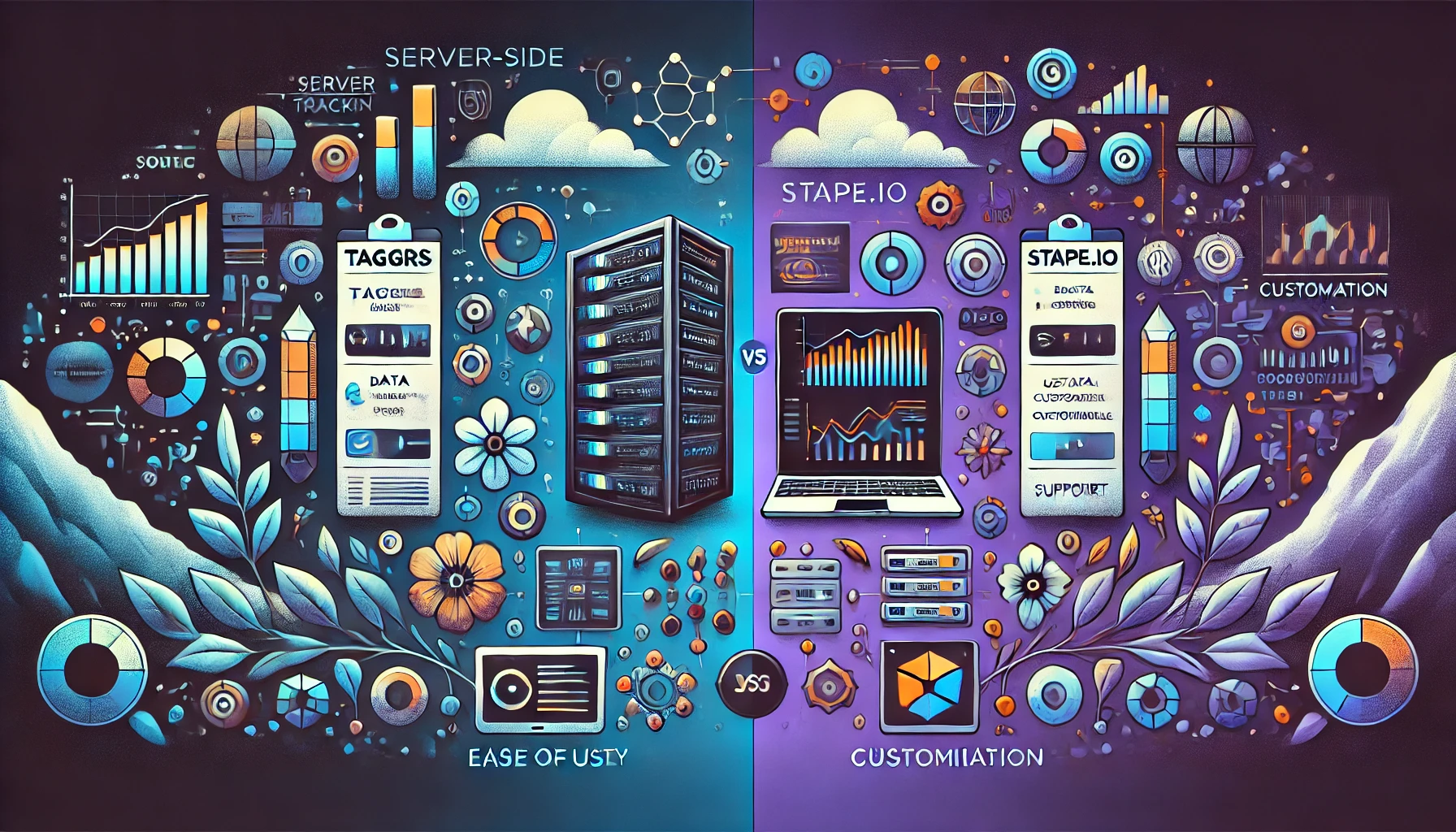Introduction
In the evolving world of digital marketing, server-side tracking has become a crucial tool for managing data more securely and accurately. Google Tag Manager (GTM) plays a significant role in this by allowing marketers to streamline their tracking efforts.
Two popular platforms for enabling server-side tracking through GTM are Taggrs and Stape.io. Both platforms offer unique features and advantages, but understanding their differences is essential to making the right choice for your business. This article will compare Taggrs and Stape.io, focusing on their features, ease of use, pricing, and support.
1. Overview of Server-Side Tracking
Server-side tracking is a method of collecting data directly from your server rather than relying on client-side methods like cookies.
This approach enhances data security, improves page load times, and increases data accuracy by reducing the likelihood of data being blocked by ad blockers or privacy settings.

2. What is Taggrs?
Taggrs is a server-side tracking platform designed to integrate seamlessly with GTM. It simplifies the process of setting up server-side tracking by providing pre-configured server environments, allowing users to focus on data management rather than infrastructure.
Key Features of Taggrs:
- Pre-Configured Environments: Taggrs offers ready-to-use server environments, which reduces the complexity of setting up server-side tracking.
- Customizable: Despite the pre-configured nature, Taggrs allows significant customization for advanced users.
- Comprehensive Documentation: Taggrs provides extensive resources and documentation to guide users through the setup process.
3. What is Stape.io?
Stape.io is another platform that specializes in server-side tracking for GTM. Known for its ease of use and flexibility, Stape.io provides a user-friendly interface that caters to both beginners and advanced users.
Key Features of Stape.io:
- Ease of Use: Stape.io is particularly noted for its intuitive setup process, making it accessible to users with varying levels of technical expertise.
- Flexible Deployment Options: Stape.io offers multiple deployment methods, including Google Cloud, AWS, and other cloud services.
- Cost-Effective: Stape.io is designed to be budget-friendly, offering competitive pricing plans that cater to different business sizes.
4. Comparison: Taggrs vs. Stape.io
A. Setup and Ease of Use
- Taggrs: While Taggrs offers pre-configured environments, it might require a bit more technical knowledge to fully customize and optimize the server-side tracking setup.
- Stape.io: Stape.io is more straightforward to set up, with a focus on user-friendliness. It offers guided steps and a simpler interface, making it a better choice for those new to server-side tracking.
B. Customization
- Taggrs: Provides extensive customization options, making it ideal for businesses with specific tracking needs or those that require advanced configurations.
- Stape.io: Offers customization but within a more simplified framework. This might be limiting for highly technical users but sufficient for most standard use cases.
C. Pricing
- Taggrs: Pricing tends to be higher due to the advanced features and the robust nature of the platform. It is suitable for larger enterprises or businesses with complex tracking requirements.
- Stape.io: Offers more affordable plans, making it accessible to smaller businesses or startups looking to implement server-side tracking without a significant financial investment.

D. Support and Documentation
- Taggrs: Provides comprehensive support with detailed documentation, webinars, and a dedicated support team for troubleshooting.
- Stape.io: While Stape.io also offers good support, it is often praised for its community support and user forums that are beneficial for troubleshooting and sharing best practices.
5. Which One Should You Choose?
The choice between Taggrs and Stape.io largely depends on your business needs, technical expertise, and budget.
- Choose Taggrs if you need a highly customizable platform with robust features and don’t mind investing in a more premium service.
- Choose Stape.io if you’re looking for an easy-to-use, cost-effective solution that still offers flexibility and solid performance.
Here’s a comparison table highlighting the differences between Taggrs and Stape.io for server-side tracking in Google Tag Manager (GTM):
| Feature | Taggrs | Stape.io |
|---|---|---|
| Setup and Ease of Use | Pre-configured environments, requires some technical knowledge for customization. | Intuitive setup, user-friendly interface, ideal for beginners. |
| Customization | Highly customizable, suitable for advanced users with specific tracking needs. | Simplified customization options, sufficient for standard use cases. |
| Deployment Options | Typically focuses on providing pre-configured servers for specific environments. | Multiple deployment options, including Google Cloud, AWS, and other cloud services. |
| Pricing | Generally higher, catering to enterprises and businesses with complex needs. | More affordable plans, suitable for small to medium-sized businesses or startups. |
| Documentation | Comprehensive documentation with detailed guides and support. | Good documentation with strong community support and user forums. |
| Support | Dedicated support team with webinars and troubleshooting resources. | Standard support with an active community for additional help. |
| Target Audience | Larger businesses or enterprises needing advanced tracking features. | Smaller businesses or those seeking a cost-effective, straightforward solution. |
| Scalability | Scales well for complex and large-scale operations. | Scalable, but better suited for smaller to medium-scale operations. |
This table provides a clear side-by-side comparison to help you choose between Taggrs and Stape.io based on your specific requirements.
Conclusion
Both Taggrs and Stape.io offer excellent solutions for server-side tracking in GTM, each with its strengths and potential drawbacks. By understanding your specific needs and comparing these platforms’ features, you can select the best tool to optimize your data collection efforts and enhance your marketing strategy. Server-side tracking is a powerful approach, and choosing the right platform is a step toward more accurate and secure data management.




